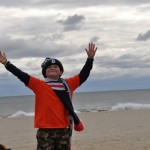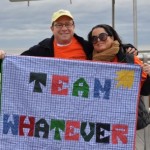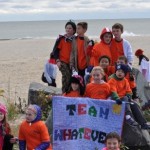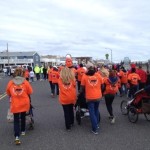Join the Collins and Berliner families for the Annual JDRF “One Walk” to Cure Type 1 Diabetes
Please join Team WHATEVER, and the Berliner and Collins Families, once again, in the JDRF “One Walk”  to Cure Type 1 Diabetes that takes place on the Avon Boardwalk in Avon NJ.
to Cure Type 1 Diabetes that takes place on the Avon Boardwalk in Avon NJ.
For a number of years, Team WHATEVER – family, friends, teachers and nurses, all supporting Lindsay (Ranney ’24) and Kieran (Ranney ‘25) – have raised over $60,000 to help find a cure for Type 1 diabetes (T1D). Even more importantly, your constant love and support of Kieran and Lindsay ensures that they stay healthy and maintain hope that one day there will be cure.
Thanks to your support, there have already been significant improvements in the  technology available to manage T1D. Every time Kieran and Lindsay eat or drink anything with carbohydrates they must be given insulin; however, now, rather than getting insulin shots, they can be given insulin through a pump controlled by a remote device.
technology available to manage T1D. Every time Kieran and Lindsay eat or drink anything with carbohydrates they must be given insulin; however, now, rather than getting insulin shots, they can be given insulin through a pump controlled by a remote device.
Although both kids must still have their blood sugar tested 8-12 times a day with a finger prick, they both now wear a Dexcom continuous glucose monitor (CGM). The CGM provides updated glucose readings every 5 minutes and the device can be connected via Bluetooth to a smart phone. This connectivity allows for real-time monitoring and alerts when the blood sugar goes too high (over 250) or too low (below 70). This is especially critical overnight!
More breakthroughs are on the horizon. The Juvenile Diabetes Research Foundation (JDRF) is funding exciting research into a variety of therapies including an artificial pancreas, which would combine the functionality of a continuous glucose monitor with an insulin pump to replicate (as closely as possible) the operation of a normal human pancreas. JDRF is also supporting research of beta cell encapsulation which involves wrapping insulin-producing beta cells in a protective barrier, which is implanted into the body. The new beta cells would release insulin when needed while the barrier protects the cells from being destroyed by an autoimmune attack.
Scientists do not yet understand the cause of Type 1 diabetes, which causes the pancreas to stop making insulin, the hormone in our bodies responsible for regulating blood sugar (glucose). Without insulin, the body is unable to break down carbohydrates, resulting in hyperglycemia (high blood sugar). Short term high blood sugar can lead to ketoacidosis, a state in which the pH of the blood is decreased making the body acidic – in extreme cases this can be fatal. High blood glucose over time causes damage to the eyes, nerves and other organs. Type 1 diabetics must also worry about hypoglycemia (low blood sugar) if they receive too much insulin or engage in exercise on an empty stomach. On any given da y, even with frequent testing and insulin management, Kieran and Lindsay’s blood glucose can range from 45 to over 300. The range of a non-diabetic is 80 to 120.
Lindsay (Ranney ’24) and Kieran (Ranney ’25) will never grow out of diabetes…
but some day we hope there will be a cure.
Kieran and Lindsay share their thoughts each year, following are some of their annual reflections on a life with Type 1.
So…I have Type 1 diabetes, if you didn’t know. People always ask what’s on my back or why I am beeping. It’s hard explaining what Type 1 diabetes is. My friends know I am ok. My best friends even know what the different beeps mean and watch out for me. The hardest part about diabetes is when my blood sugar is really high or really low. When my blood sugar is above 400, there is pretty much a 90% chance I will start throwing up in about 30 minutes. Being low isn’t good either. Usually I just feel tired, but if I don’t watch out, I could fall asleep, which can lead to a coma. Luckily, my mom and dad are always watching out for me so I don’t have to worry about it too much. Sometimes you just want to be a kid and not worry about stopping to test or wondering if I need a snack or more insulin.
I am going to explain to you why it’s so important to support this cause. I am very lucky that I have Type 1 and not something else. Type 1 is easier to manage than many other diseases, but regardless we’re so close to finding a cure. That’s another reason why I’m so lucky. It would be very kind of you to donate, and help all of those people that have Type 1, including me, Lindsay, and Ryan.
Lindsay – 2017
When people see me, they may think that I look completely fine. I act like any normal 11-year-old, however if you look at what it is like living with Type 1, you would see a different picture. My diabetes doesn’t take any time off. Even while I am sleeping my parents have to watch my blood sugar levels. There are times during the day that I need to stop whatever I am doing to prick my finger and test my blood sugar, this could be in the middle of fun activity like dance. No two days are alike. I can eat the same foods or do the exact same things and my blood sugar numbers will be totally different. It is hard for me to talk about the sad times dealing with my diabetes. On our summer trip to Cape Cod, my insulin pump got unknowingly disconnected for a few hours after dinner. My blood sugar went up to over 400. I was so sick, I felt like I was going to throw up and I could barely talk. It was scary because the nearest hospital was 45 minutes away.
Thank you for all your support. I am hopeful that there will soon be a cure. I have already seen many advancements on how I manage my diabetes since I was diagnosed at 6 years old. It really makes a difference. I like to say that me and my fellow diabetics are fighters and nothing can stop us.
2016
Kieran said “You would think that this disease, diabetes, would ruin your life and damage your normal lifestyle, but now that I have had it for six years, it’s whatever, this is how I live and I don’t know how to live any other way. But this summer I was at sailing camp and I was really low and I didn’t have any juice left. I fell asleep in my boat and my counselors didn’t see me. Luckily my mom called me on my cell phone and woke me up (if she didn’t I might have gone into a coma!). She knew I was super low because of my Dexcom (continuous glucose monitor)—it sends my sugar levels through Bluetooth to my phone and my mom gets my numbers on her phone. When I was diagnosed, you had to prick your finger every time you wanted to see your number. Now I can just look on my phone and see, “122, that’s a perfect number.” I used to have shots that hurt me, annoyed me, and left bruises on my arm. Then we got the Omnipod (insulin pump) and the Dexcom. Someday there might be a robotic pancreas! All of the people who have supported our JDRF walk every year are helping make life normal. I just want to say thank you and I am so happy that you are being so generous to help cure Type 1 and all of the people in the world that have diabetes. Really, thank you.
Lindsay shares, “This Summer I went to sleep away camp for 2 weeks. It wasn’t any ordinary sleep away camp. All the counselors and campers had Type 1 Diabetes, just like me. There were nurses that tested me every night while I was asleep at 11:00 pm and 3:00 am. It was really nice having everyone around me who understood what it felt like to have high or low blood sugars, who knew why I tested my blood before each meal, and why I wear a white plastic pump on my arm. I am learning how to take care of myself more independently. I was given the responsibility of counting my carbohydrate intake at every meal. I also learned how to change my insulin pump on my own and was able to move it from my arms to another part of my body for the first time in three years. I shared a bunk with 7 really nice girls (ages 8-12 years old) and 4 counselors. We were assigned bunk and kitchen chores, slept outside under the stars and went on a white water rafting trip down the Delaware River. Being my first time away from home I was extremely homesick. (Thank you to everyone who wrote to me.) It was an experience I will never forget. When I was first diagnosed I thought it was going to be the end of the world. As much as I hate it, it’s made me a stronger person and made me tough. I now know I can do anything if I put my mind to it. I am proud to walk with all of you amazing people to help find a cure. Thank you for your continued support. ”
2015
In 2015, Kieran shared the following advice to a friend of the family diagnosed with T1D, “Diabetes is hard when you first get it. But I’ve been doing this since I was 3 so you actually grow into it. It’s getting a lot easier now that there are pumps and sensors. I am glad that you are getting it now instead of then. So stay strong and try not to cry when you get blood checks. I know I did, if it makes you feel any better. The main rule is that you can’t sneak food, but you can eat whatever you want. It’s not a diet, or Type II diabetes. All you need to do is get insulin. I know it will hurt, but you will get used to it after a while. And someday, I know there will be a cure for diabetes and you can be a normal kid again.”
To help us in our efforts to find a cure for T1D, please consider making a donation, joining our team, or both! We would love to have you with us in person or in spirit on the day of the walk. And also know, that we are committed to this cause for the long-term and will be participating in this walk each year until there is a cure….please don’t feel obligated to donate every year.
JDRF “ONE Walk “
Why Team WHATEVER? Because we will do whatever it takes to keep Kieran and Lindsay healthy and thriving, and together, we will do whatever it takes to find a cure for T1D.
THANK YOU FOR BEING ON OUR TEAM!
Love,
Andrew, Jackie, Lindsay and Brooke Berliner and Tris, Jennifer, Crosby and Kieran Collins











